(Rewritten, compressed and partly corrected version)
I try some trivial rotation of a triangle in 3d to point its normal straight up without any distortion. I'm following this post calculate-rotation-matrix-to-align-vector, but for some reasons, my result is undesirable and I can't see the error in my code or my error in reasoning. My Python code as followed:
# defining the triangle with three points in 3d space (xyz)
v1 = [1,1,1]
v2 = [2,2,2]
v3 = [2,1,3]
# calculating the normal and converting to unit-vector
n = np.cross( np.subtract(v2,v1), np.subtract(v3,v1) )
a = n / np.sqrt( n[0]**2 + n[1]**2 + n[2]**2 )
b = [0,1,0]
v = np.cross(a,b)
s = np.sqrt(v.dot(v))
c = np.dot(a,b)
Vx = np.array([
[ 0 , -v[2], v[1] ],
[ v[2], 0 , -v[0]],
[-v[1], v[0], 0 ]
])
Vx2 = Vx.dot(Vx)
I = np.identity(3)
iv = (1/(1+c))
# single rotation matrix
R = np.add(I, np.add(Vx, np.multiply(Vx2,iv)))
Then calculating the centroid, the rotation matrix as described and also as separated matrices as explained here Rotating a Vector in 3D Space
cx = (v1[0]+v2[0]+v3[0]) / 3.0
cy = (v1[1]+v2[1]+v3[1]) / 3.0
cz = (v1[2]+v2[2]+v3[2]) / 3.0
v1t = [v1[0]-cx,v1[1]-cy,v1[2]-cz]
v2t = [v2[0]-cx,v2[1]-cy,v2[2]-cz]
v3t = [v3[0]-cx,v3[1]-cy,v3[2]-cz]
As well as the single rotation matrices:
rz = np.array([
[c,-s, 0],
[s, c, 0],
[0, 0, 1]
])
ry = np.array([
[ c, 0, s],
[ 0, 1, 0],
[-s, 0, c]
])
rx = np.array([
[1, 0, 0],
[0, c,-s],
[0, s, c]
])
rxyz = rx.dot(ry).dot(rz)
Now I apply the rotation, with R and rxyz:
p1 = R.dot(v1t)
p2 = R.dot(v2t)
p3 = R.dot(v3t)
p4 = rxyz.dot(v1t)
p5 = rxyz.dot(v2t)
p6 = rxyz.dot(v3t)
The result is now better than the first approach and the Y of p1 and p3 are the correctly same, but p2 is still wrong. And there still seems to be a distortion.
P1-3 (red)
- [-0.20673470096224283, 1.1102230246251565e-16, -1.2299659828522118]
- [-0.5865305980755144, -3.885780586188048e-16, 0.45993196570442385]
- [0.7932652990377571, 1.1102230246251565e-16, 0.770034017147788]
P4-6 (blue)
- [-1.1482080390363765, 0.30059830961195716, -0.38316381732390803]
- [0.3040075530555323, -0.6336677067539932, -0.2481938771563051]
- [0.8442004859808443, 0.3330693971420361, 0.6313576944802128]
The light gray triangle is the original translated to 0,0,0 and red and blue are the rotated ones.
